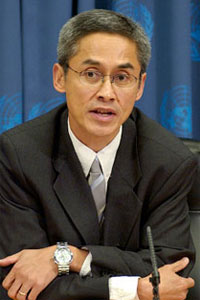The Asia-Pacific region is a vast conglomeration of large and small countries with a wealth of inter-generational wisdom. Yet, the region does not have a regional inter-governmental human rights protection system. What, then, are some possibilities for the future?
There are encouraging signs. First, all Asia-Pacific countries are parties to the Convention on the Rights of the Child, followed by a majority as members of the Convention on the Elimination of All Forms of Discrimination against Women and the Convention on the Rights of Persons with Disabilities.
Also, almost all countries are parties to the Paris Accord on Climate Change, emanating from the UN Framework Convention on Climate Change, together with other key agreements on the environment.
Stocktaking of the region reveals various portals for identifying developments; most are at the sub-regional level rather than at the regional level. The Asean setting is the most evolved. It is a blend of 10 countries which are at different stages of the path towards democracy.
Pursuant to the Asean Charter, its capstone, it established the Asean Intergovernmental Commission on Human Rights (AICHR). There are two companion sectoral bodies: the Asean Commission on the Rights of Women and Children and the Asean Committee on the Rights of Migrant Workers. After the AICHR was established, it formulated the Asean Declaration on Human Rights as a "soft law" to guide the human rights approach in the region.
Gradually, the AICHR has progressed towards more human rights protection at the sub-regional level. Importantly, through its work plan, it now receives communications from affected parties who seek remedies. The procedure is low-key and dependent upon the efforts of each representative to leverage for remedies.
National human rights commissions now also exist in five of its 10 member countries, and at times, they have cooperated on trans-frontier issues, such as the protection of children and the environment. Southeast Asian countries have also set up the Southeast Asian Network of National Human Rights Institutions (SEANF), covering Timor-Leste. A welcome development is that now the AICHR is meeting the SEANF more consistently.
The area covered by the South Asian Association for Regional Cooperation (SAARC) is a very populous region with some challenging situations nearby. To date, the entry point for human rights development at the SAARC level has been various human rights treaties and declarations of a cooperative kind. There is a convention to counter the trafficking of women and children, and a convention on child welfare arrangements. There is also a social charter to complement the SDGs and also an environmental treaty. The approach is based on promoting human rights.
Parallel to this, some SAARC countries have strong national human rights commissions as well as other mechanisms, such as active courts, which provide a check and balance to ensure human rights protection on various fronts at the national level.
The proactive nature of the Supreme Court of a key country has been recognised on a number of issues, including on child labour and environmental protection. Meanwhile, as a good practice, one of the National Commissions on Human Rights has managed to clear a huge caseload of complaints, offering hope to remedy grievances.
In West Asia, there is the Arab system, which straddles that sub-region and North Africa. This consists of the Arab Charter on Human Rights with a backup committee to monitor implementation by states. There is also a political arm nearby in the form of the Arab League.
More recently, there has been an initiative to establish an Arab Human Rights Court. There are substantive and procedural considerations. The said committee and the proposed court do not provide for channels to receive complaints directly from individuals seeking redress.
There has also been a growth of national human rights commissions, which provide for gradual, increased exposure to human rights issues, as well as advocacy from improved protection.
The Pacific Islands Forum is an organisation that harbours a range of large and small island nations. An offshoot of its work has been to support a human rights agenda and mechanisms on human rights. While there is still no mechanism at the sub-regional level, there are national human rights commissions in the region with a role to promote and protect human rights.
Parallel to this, under the auspices of the Pacific Community, the biggest Pacific Regional Forum on National Human Rights Institutions was held in February 2023, and there was common agreement on the importance of developing such institutions in the region, with an emphasis on accessibility.
Then, there is the network of national human rights institutions (NHRIs) interlinked by the Asia-Pacific Forum of National Human Rights Institutions (APF). The APF has been instrumental in supporting the setting up and capacity building of national institutions in the form of commissions and ombudspersons in the region, and the numbers have grown impressively to over 25 national institutions as part of the network.
A key mandate of these NHRIs is not only to promote but also to protect human rights. The latter involves reception of complaints/communications from affected parties, coupled with the advocacy for and provision of redress.
At the field level, visits to prisons and other closed or semi-closed institutions where people are held or detained have been a good practice on the part of many of these institutions, which should be maximised.
Yet, beyond the national human rights commissions, at the sub-regional level, most mechanisms in the Asia-Pacific region are more concerned with human rights promotion, such as through dialogue and the issuance of statements to foster human rights rather than human rights protection.
There is a pivotal need to develop their protection role. This would require the building of an architecture for channels of communication for complaints, monitoring, investigations, fact-finding, a protective shelter for human rights defenders, and effective levers for remedies.
